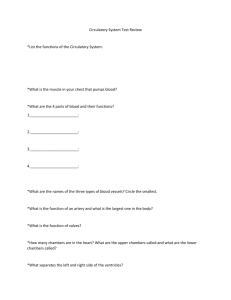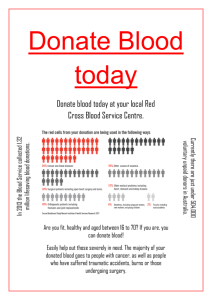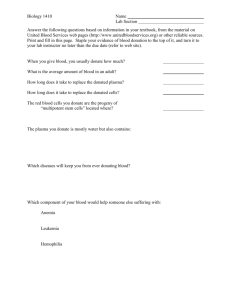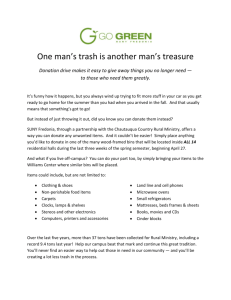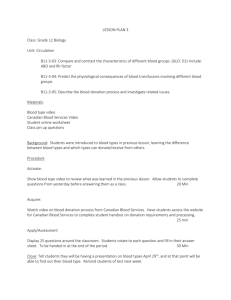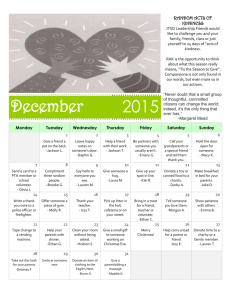Supported by: Body Systems and ABO blood types Grade 6 Lesson
advertisement
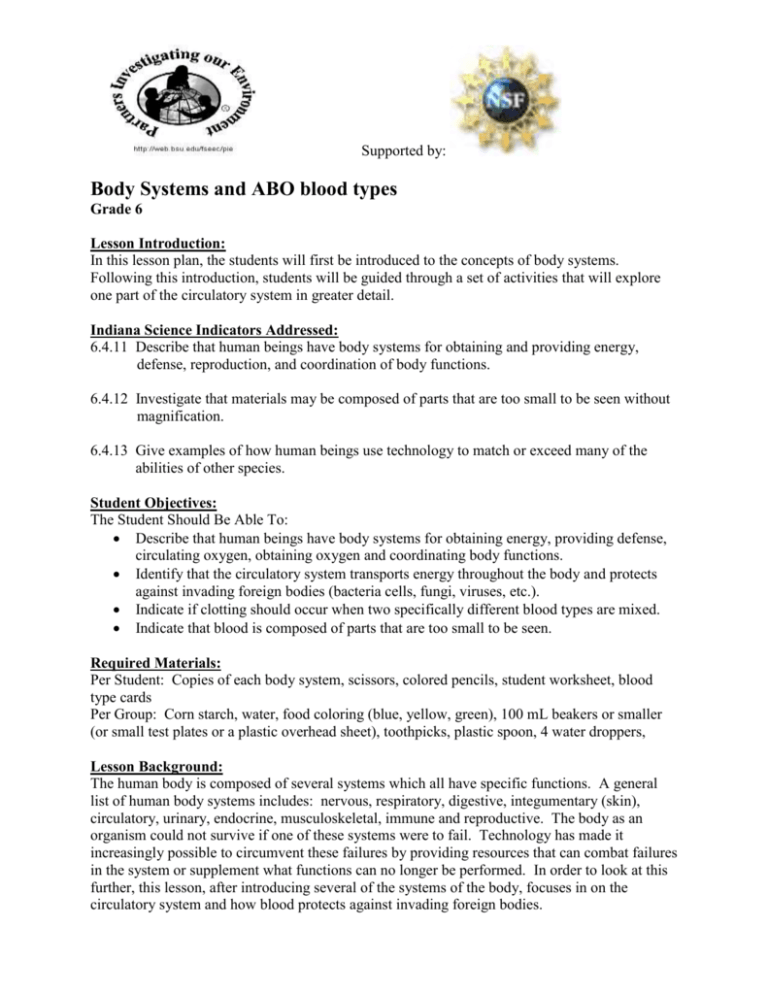
Supported by: Body Systems and ABO blood types Grade 6 Lesson Introduction: In this lesson plan, the students will first be introduced to the concepts of body systems. Following this introduction, students will be guided through a set of activities that will explore one part of the circulatory system in greater detail. Indiana Science Indicators Addressed: 6.4.11 Describe that human beings have body systems for obtaining and providing energy, defense, reproduction, and coordination of body functions. 6.4.12 Investigate that materials may be composed of parts that are too small to be seen without magnification. 6.4.13 Give examples of how human beings use technology to match or exceed many of the abilities of other species. Student Objectives: The Student Should Be Able To: Describe that human beings have body systems for obtaining energy, providing defense, circulating oxygen, obtaining oxygen and coordinating body functions. Identify that the circulatory system transports energy throughout the body and protects against invading foreign bodies (bacteria cells, fungi, viruses, etc.). Indicate if clotting should occur when two specifically different blood types are mixed. Indicate that blood is composed of parts that are too small to be seen. Required Materials: Per Student: Copies of each body system, scissors, colored pencils, student worksheet, blood type cards Per Group: Corn starch, water, food coloring (blue, yellow, green), 100 mL beakers or smaller (or small test plates or a plastic overhead sheet), toothpicks, plastic spoon, 4 water droppers, Lesson Background: The human body is composed of several systems which all have specific functions. A general list of human body systems includes: nervous, respiratory, digestive, integumentary (skin), circulatory, urinary, endocrine, musculoskeletal, immune and reproductive. The body as an organism could not survive if one of these systems were to fail. Technology has made it increasingly possible to circumvent these failures by providing resources that can combat failures in the system or supplement what functions can no longer be performed. In order to look at this further, this lesson, after introducing several of the systems of the body, focuses in on the circulatory system and how blood protects against invading foreign bodies. The importance of blood type and transfusion can be seen when you take a close look at the circulatory system in which the blood cells travel. The circulatory system is an integral part to not only the transportation of energy and the materials needed for cells to produce energy, but also as a safety mechanism to protect the body from hazardous cells. This transportation includes the ability of red blood cells to use the protein hemoglobin to carry oxygen throughout the body to where it is needed. Food sources such as sugars can be dissolved within blood so that they may also be used throughout the body. Lastly, white blood cells are the defensive soldiers of the blood that attack cells that have antigens which the body recognizes as bad and produces antibodies against. Antigens are molecules that are present on red blood cells that are used to identify the cell to the body. Antibodies are proteins secreted by the white blood cells that recognize and attach to certain antigens and allow the immune system to attack invading cells. The combination of these antigens and antibodies present in the blood determine the blood type of the individual. In this lesson, students are introduced to one of the antibody-antigen systems in blood. The ABO system is one example of the mechanisms in living organisms that protect themselves from outside invasions. The ABO antibody-antigen system is the result of the genes we receive from our parents. Type A: Type A blood has the A-antigen on the red blood cells (RBC). Type A blood also has anti-B antibodies. In the presence of B-blood, the antibodies in A will attack the antigens of B and agglutination occurs. Type B: Type B blood has the B-antigen on the RBCs. Type B blood also has anti-A antibodies. Just like Type A blood, agglutination can occur if A antigens or B antibodies are introduced into it. Type AB: The type of blood contains both A and B antigens on the RBCs. However, Type AB does not have either A or B antibodies. This allows a person with AB blood to receive transfusions from A or B type donors. Type O: O blood type is when the RBCs contain no A or B antigens but does contain both A and B antibodies. Since O has no antigens, it is not recognized as foreign by other blood types and thus persons with Type-O are considered the universal donor. One point you may have noticed is that the donated blood usually has antibodies that could react with the recipient. Even though this is true, since the amount of transfused blood is typically small compared to the amount present in the body, the negative effects are outweighed by the positives. Another antigen found in RBCs is Rh factor. Persons with these antigens are said to be Rh positive while those without are negative. The interactions between Rh antigens and antibodies are similar to the ABO system. Procedures: Day 1 and 2: Before First Class: Make enough copies of the individual system pictures (at end of lesson) so that each student has all five models. 1. Begin by asking students, “What is a system?” and collect several student responses. 2. Explain to the students how a system is a group of interrelated, interacting, or interdependent parts forming a complex whole. 3. Next, ask students, “How does the human body act as a system?” 4. Use students’ answers and explain that the human body has many parts that interact and interdependent (e.g., arm and hand, circulatory and respiratory systems). 5. Instruct students to try to identify each human body system. 6. Show the overhead of the BLM Body Systems and have students identify each human body system. Have students cut out each. 7. Direct students to look at the phrases listed on the chalkboard. 8. Instruct students to decide which phrase corresponds to each human body model. Monitor and guide students as they decide. 9. Have students hold up the corresponding model as you discuss each system in this order: a. The digestive system is responsible for digesting food, which provides energy for all body functions. b. The respiratory system is composed of organs, which obtain oxygen. The blood picks up oxygen and carbon dioxide is exhaled. c. The circulatory system is composed of organs, such as the heart arteries, which are responsible for blood and related chemical circulation. d. The nervous system, composed of organs such as the brain, controls the flow of information in the body. e. The integumentary (skin) system is an excellent protector from exposure to foreign elements. The nervous system and immune system also provide protection from foreign elements and danger (e.g., nervous system provides sensory input, which keeps us alert to small and large dangers). 10. Direct students to color each model and write the corresponding function on the back of each. 11. Ask students: “Are there other systems of the human body?” 12. Discuss with students how there are equally large system and thousands of smaller systems working together constantly to keep the human body working properly. 13. Ask students: “Could one system survive on its own without the others?” 14. Discuss with students how each system is interconnected in some way (e.g., the respiratory system obtains oxygen and the circulatory system transports oxygen to other systems, such as the muscular system). 15. Direct students to staple their models to make a booklet, using the integumentary system as the first page. Engagement: 16. Write the following phrases on the chalkboard: “obtain energy,” “provide defense,” “coordinate body functions,” “obtain oxygen and release carbon dioxide,” “transport blood and chemicals in body.” 17. Ask students: “Based on what you know about human body systems, which system might do each job listed on the board?” 18. Discuss students’ answers and distribute the five body system models, scissors, and colored pencils to each system. Day 3: 1. Review the basic body systems covered in the past two days. Use questions such as: a. What body system is important for controlling how information moves around the body? Nervous b. The lungs, esophagus, mouth and nose are part of what body system? Respiratory c. What other body system could the mouth also be part of? Digestive d. What large body system protects us from outside substances? Integumentary (skin) system e. What body system carries blood and oxygen throughout the body? Circulatory f. Are their other body systems that you are aware of? Urinary, Endocrine, Musculoskeletal, Reproductive, Immune 2. Explain to students that now that they have a general understanding about body systems, you will focus their attention to one body system to understand how important each system is to our survival. Indicate that they will be focusing specifically on the circulatory system and have the students identify what features this system does. Write these answers on the board 3. Explain that as scientists understand more and more about our body systems, they have developed methods and technology to help us when our body systems begin to have trouble (injuries, diseases, infections, etc.). Exploration #1: (15-20 minutes) 4. Have students get into groups of two or three. 5. Have one student in each group hold out their hands and scoop one spoonful of cornstarch into the hands of the student. Have the students run their fingers through the cornstarch and describe what they feel in one of their science journals. 6. Give the other student a water dropper with water in it. Have each group describe water in their science journal. 7. Instruct the other students to add five drops of water to the cornstarch. Have students mix in hands. 8. Instruct second student to add one drop at a time until the material is firm when pressed and liquid when not. (the mixture will have the right consistency when a one-to-one ratio is reached) 9. Have students share with their partners. 10. Ask them to describe to their partners what it feels like and what they think it is. 11. Have students clean up by putting in trash and washing remainder off hands. 12. Have students write in journal about what they think changed about the substance when pressure was applied and what happened when pressure was released. Day 4: Exploration #2: (40-50 minutes) Before Class: Get three 500 milliliter beakers and fill each to the 500 mL mark (about 2.25 cups). Into one beaker, add 5 drops of yellow liquid food coloring. Into a different beaker add 5 drops blue food coloring. Into the third beaker add 10 drops green food coloring. Then distribute smaller beakers of each color and one of plain water to each lab station (or if the students are to work at their own desks, put them on trays including beakers.) Also include a testing plate (or small clear beakers or just a plastic overhead sheet) for each group and four droppers. (Lab Notes: When preparing the food coloring solutions be conscience about how well the green food coloring masks the blue and yellow colors. Because different manufactures may affect the coloration of the solutions, it is recommended that the teacher run the experiment beforehand to confirm that the solutions will work as desired. Also, you may also find that students are able to identify the colors of the solutions better if a white piece of paper is kept under the testing vessel or surface.) 1. Explain to students that when people donate blood to each other sometimes the blood from one person clumps (the small particles in blood bind together into larger masses much like yesterday’s mixture) with the other and causes a blockage but that other people can donate blood to other and it will not clump. Today they will simulate which blood types a person who is injured can get from others and which kinds will cause clumps. 2. Hand out the student worksheet at the end of the lesson. 3. Instruct students that we will use food coloring to represent the four basic blood types of people: A B AB O. Write the following information on the board: A-Yellow, B-Blue, AB-Green, O-Clear water. 4. According to the worksheet (included at the end of the lesson), students will mix different colors (blood types) and indicate if each mixture stays the same color-a successful donation, or if the mixture changes color-an unsuccessful (clumping) donation. Instruct students to use one dropper for each color and that they only need to use a couple of drops each time. Provide any other basic instructions for groups to get started and monitor progress. 5. It is recommended that the teacher walk the students through the first two tests so that students are clear on how to complete the worksheet. 6. While students are working, copy table from the student worksheet on board or onto an overhead transparency. 7. Once the groups have tested their samples, have the students clean up their supplies. 8. After students have returned to their seats, go through the worksheet and have students tell you if there were reactions or not between what blood types. Collect the worksheets. Day 5 and 6: Explanation: (30-40 minutes) 1. Describe how blood is used to donating to other persons. a. During this discussion, make sure to incorporate these topics: i. What are the four blood types of people? ii. What does blood do? iii. How does it do it? Make sure you talk about the small molecules in the blood that carry oxygen to the body cells (Hemoglobin, myoglobin), clotting particles, dissolved substances in the blood like sugars, etc. iv. Why is blood important to the body? v. What would happen to the body if blood weren’t there? What causes us to loose blood? vi. Talk about how by being able to donate blood to others, we are able to prevent persons from dying at times when other organisms would die. vii. Talk about how people have other factors that influence whether one person can donate to another such as Rh. 2. For homework, have students try to find out what blood type they are and what blood types their family members are. Inform them that their parents may know this information or it should be included on their birth certificate. Elaboration: (30-40 minutes) 1. Before class make enough copies of the blood type cards and cut apart. (Please note: the card pages below include some cards with both ABO and Rh and others with just ABO. 2. 3. 4. 5. 6. This allows you the flexibility to introduce the additional Rh factor if time allows. Otherwise, only the ABO cards would be necessary.) Ask students that know their blood type to raise their hands. Give these students their blood type card. For students who do not know their blood type, randomly distribute other cards to students. Instruct students to put their name at the top of their cards. They should then circulate around the room and determine what students in the room they would be able to donate to and receive blood from. Tell students how long they have to find at least 2 persons for each blood type groups. Once that time has arrived, have the students take their seats. Choose students from each blood type and randomly put their names on the board (or overhead). Have students tell you who that student can donate to and who they can receive from. Use arrows to show this donation. Ask the students to discuss how donating and receiving blood by O (or O-) blood types are different from that experienced by AB (or AB+) blood types. This could be done in science notebooks. Collect the students’ cards and notebooks for grading. Evaluation: To evaluate this lesson, there are several choices. 1. Collect and grade the student worksheet for completeness and accuracy. 2. Monitor students’ participation in class discussions and questioning. 3. Use the following questions to quiz student understanding following the lesson. a. How does the human body act as a system? b. Can systems be made up of smaller systems? How do you know? c. How does each body system carry out its function? How do you know? d. What is the function of the ________________ system? e. What are the four basic blood types? f. If a person has AB type blood, what blood types can this person donate to? g. What types of blood can a person with a blood type of AB receive for a donor? h. Why would not knowing what blood type a person has be a problem if they were involved in an accident? i. On the news, they often say the blood center is critically low on O-type blood but rarely mention other types. Why might O-type blood be more critical to blood centers? The introductory engagement and parts of the assessment activities were taken directly from the Indiana Academic Standards website: http://www.indianastandardsresources.org/files/sci/sci_6_4_11.pdf Written by: Cheryl Kellogg and Dustan Smith, PIE Fellows, Ball State University Student Worksheet ABO Blood Types Name: ______________________________ Class: _______________________ Student Instructions: Follow all instructions given to you by your teacher. Information: In this activity, you will be simulating what happens when the same and different blood types are mixed. Since blood can carry diseases, you will use colored water to mimic the way blood interacts. Look at the chart below. Across the top are the blood types of a person receiving blood. Down the side will be the donor’s blood type. For each part of the chart, you will check to see if those two blood types clump or not. How To Test: Each square of the chart is an individual test. Put 6 drops of the receiver’s blood type that is at the top of the column in your test vessel. Add 3 drops of the donor blood type to the test. Stir with a clean toothpick. Did the color of the recipients blood change? o The blood donation is good if the original color does not change. Put a G for good in the box. o If the mixture is not the original color, a bad reaction has occurred. Put a B in the box. The Test: Receiving Blood Types Donated Blood Types A-type (Yellow) B-type (Blue) AB-type (Green) O-type (Clear) A-type (Yellow) B-type (Blue) AB-type (Green) O-type (Clear) Questions: 1. What donated blood type did not cause a bad reaction? _____________ 2. Yes or No Is any receiving blood types better at accepting donor blood? Why or why not? ___________________________________________________________________ ________________________________________________________________________ ________________________________________________________________________ 3. If you had type B blood, what blood types could donate to you if you were in an accident? __________________________________ Your name: _______________ A Can Donate To: Can Receive From: Your name: _______________ AB Can Donate To: Can Receive From: Your name: _______________ Your name: _______________ B Can Donate To: Can Receive From: Your name: _______________ O Can Donate To: Can Receive From: Your name: _______________ A pos A neg Can Donate To: Can Receive From: Can Donate To: Can Receive From: Your name: _______________ Your name: _______________ B pos B neg Can Donate To: Can Receive From: Your name: _______________ Can Donate To: Can Receive From: Your name: _______________ AB pos AB neg Can Donate To: Can Receive From: Your name: _______________ Can Donate To: Can Receive From: Your name: _______________ O pos O neg Can Donate To: Can Receive From: Can Donate To: Can Receive From:
